
Get Started
Graphite's supplier management tool helps you onboard faster, cut time on risk reviews and streamline supplier validations. Save time and money.
April 19 2023
Managing Tail Spend in Procurement to Control Costs & Boost Efficiency
Managing your tail spend is critical to control costs and improving proficiency. The tail spend management strategies below can help you reduce unnecessary expenses, streamline your procurement process, and improve your bottom line.
What is tail spend in procurement?
Tail spend in procurement describes infrequent, low-value purchases that can add up significantly over time. These small purchases may include office supplies, maintenance and repair services, travel, and small equipment purchases.
The term “tail” refers to the end of a distribution curve with many small transactions.

Although tail-end spend usually represents only a small percentage of an organization’s total spending, it can be complex and challenging to manage since it often involves many suppliers and thousands of transactions.
The exact tail spend definition varies from company to company and depends on your spend threshold.
Tail spend management framework: How to manage tail spend in procurement?
Effective tail spend management is essential to mitigating risk (such as limited visibility, compliance issues, increased costs, and reduced quality) and ensuring your organization gets the best value for the money spent. Plus, it can help you save time in your procurement process, which offers significant savings. Yet, many procurement teams shy away from manage your tail spend as it can be overwhelming due to the complexity of expenses.
Use the following steps as your basic tail spend management framework to help you:
Step 1: Start with a tail spend analysis
To conduct tail spend analysis, you first need to define what it means in your organization:
- Define your threshold: Your threshold is the spend amount that draws a line between strategic and tail spend. Anything under the threshold is tail spend.
- Define your frequency: Anything outside your usual spend frequency is your tail spend.
- Define your priority: If it’s a low-priority item based on your production needs, it’s also tail spend.
Step 2: Create tail spend categories
Categorizing your tail spend is the second step to effectively managing it. Of course, this all depends on your business. Generally, tail items are products and services that aren’t necessary for your company’s core production process but are required for other, typically internal, business activities.
Common tail spend categories include:
- Administrative – Stationary supplies, including paper, pens, post-its, furniture, and other items your organization needs to perform that are secondary to your core business purpose.
- Hardware – Computers, cars, printers, clothes, and other materials.
- Travel – Depending on your organization, this can be a major or a minor expense and involves managing air travel tickets, rental vehicles, hotels, ride shares, and more.
- Maintenance – This includes cleaning supplies, services, and repairs.
You’ll want to adjust these categories of indirect spend items according to your needs.
Step 3: Allocate tail spend suppliers
Once you’ve categorized your items, you can allocate your tail spend suppliers directly. Next, create a list of suppliers delivering only products and services in that category. Categorizing suppliers will streamline your workflow and make finding suppliers much faster.
Build your tail spend management strategy
Procurement optimization starts with being well-organized and this means following a tail spend management framework to create a tail spend management strategy. Improperly managed tail spend opens your organization up to additional risk and unnecessary spending.
Here are four tips to help you save on tail spend:
- Track your spending – Gain insight into your spending patterns and pinpoint areas where you can save the most money.
- Manage supplier data – Always have the most up-to-date supplier information to save time.
- Track performance – Identify low-performing, high-risk suppliers and prioritize those with proven and positive track records.
- Leverage your spend data – Know how much and how often you spend with a supplier to negotiate and secure better procurement deals.
A report by the Boston Consulting Group estimates that using digital tools to manage tail spending can cut annual expenditures by 5% – 10% on average.
Ready to learn more?
Graphite Connect is a one-of-a-kind supplier lifecycle and risk management solution that can help you better manage tail spend, mitigate risk, and get the most out of your supplier partnerships.
Request a Demo




